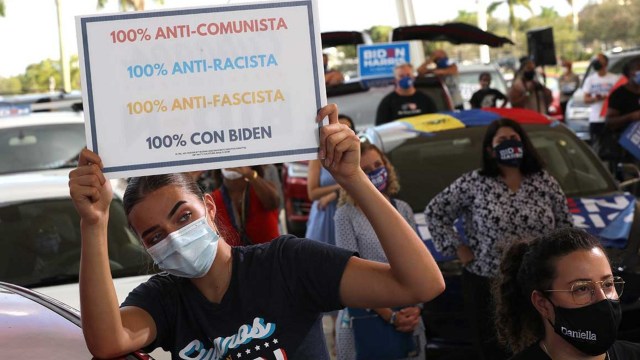
“The first step is admitting there’s a problem, and there’s a lot of people in my movement and my party that don’t,” said one strategist.
By Político– Sabrina Rodríguez
Jan 18, 2022
Democrats admit they’re losing ground with Latino voters.
But Latino Democratic leaders and operatives are increasingly worried that time is running out to do anything that would make a significant difference ahead of the 2022 midterms, when the party needs a robust Latino turnout to preserve its slim majorities in Congress.
For years, those leaders have warned that the party needs to invest earlier in outreach, hire more Latinos for decision-making positions and talk to Latino voters about more issues than just immigration.
“Intellectually, Democrats know they have a problem,” said Maria Teresa Kumar, founding president and CEO of Voto Latino, a grassroots political organization. “But I haven’t seen the investment that needs to happen for it to translate.”
Latinos – the largest of the nation’s fastest-growing demographic groups — have long been viewed as solidly blue Democratic voters. While President Joe Biden captured the majority of the Latino vote in 2020, Trump improved his margins in 78 of the nation’s 100 majority-Hispanic counties.
Since then, a spate of reports, analyses and polls have made it clear that the party has reason to worry if it doesn’t change its current approach. A recent report by Democratic research firm Equis found that a majority of Latinos believe that Democrats take them for granted. It also found that Trump’s policies on the coronavirus pandemic and economy were popular among Latinos and that GOP attacks claiming Democrats embrace socialism have been effective.
Another analysis by Democratic voter data firm Catalist found that, while six in 10 Latino voters backed Biden, Trump’s share of the Latino vote increased by 8 percentage points compared to 2016.
Kumar points to Florida – where Trump saw some of his largest gains with Latinos, both among conservative-leaning Cuban Americans and voters from other Latin American countries, such as Colombia, Venezuela and Nicaragua – as an example of Democrats having “a deficit in communications and connection.”
“Trump and the Republican Party never left Florida. They kept cultivating and communicating with the Latino community,” Kumar said. “Sure, a lot of it was disinformation and messaging that Biden is a communist and a socialist, but they kept doing it – and it was effective.”
One Democratic super PAC found that the party’s English-language ad spending dwarfed Spanish-language ads in numerous Latino-heavy House districts that Republicans flipped in 2020.
According to a spreadsheet shared with POLITICO – assembled out of frustration by the super PAC, which favored more Spanish-language ads – Democratic groups combined to spend almost $5 million in English-language ads in California’s 39th Congressional District, and not a cent on Spanish-language ads.
In that district, which is more than 30 percent Latino, Democratic incumbent Gil Cisneros lost to now-GOP Rep. Young Kim by just over 4,000 votes.
In the nearby 48th District, which is about 20 percent Latino, Democrats spent just $33,000 in Spanish-language ads, compared to more than $12 million spent in English-language ads. Democratic incumbent Harley Rouda lost narrowly there to Republican Michelle Steel.
“It should be a wake-up call to Democrats. When there are no people of color at the decision-making level of a campaign, our constituency becomes an afterthought and you underperform because you’re not reaching out to them with the same priority as white suburban ‘persuadable’ voters,” said Chuck Rocha, a Democratic strategist and former senior adviser to Sen. Bernie Sanders’ (I-Vt.) presidential campaign.
Latino operatives say part of the problem is that there is still a contingent in the party denying there’s a ‘Latino problem,’ despite mounting evidence that it’s no longer a certainty that Democrats will receive an overwhelming majority of the Latino vote in elections.
“Is it going to change? Well, the first step is admitting there’s a problem, and there’s a lot of people in my movement and my party that don’t,” Rocha said. “I love Democrats, and I’ve never voted for anybody that wasn’t a Democrat, and I’ll admit there’s a problem… because that’s the only way to change.”
One reason why Democrats fail to change their game plan with Latinos, Rocha said, is because campaigns don’t hire Latinos for top jobs and keep hiring the same consultants that have lost races in Latino-heavy districts. In many of the 2020 races, all the Spanish-language ads by Democrats were done in the last 30 days before the election, he said, signaling that Latinos were not a priority. The ads also came after many Latinos already had hardened opinions about the candidates, making it too late to persuade voters, he added.
Meanwhile, he said, Republicans saw success in 2020 as they “started spending real resources in bilingual communications to a broad target” and connected on Facebook, YouTube and via mail with a “whole bunch of Latinos who have never heard a compelling argument from Democrats about why they should vote for them.”
Some Latino Democratic operatives noted that the GOP is making a concerted effort to make inroads with Latinos and is already spending money to communicate with Latinos ahead of the 2022 midterms.
“Democrats are not doing that in the same way. They’re trying to get up to speed, and I think they realize they’re kind of outgunned right now,” said Colin Rogero, partner and creative director for Democratic firm 76 Words, who has worked on many campaigns in Latino-heavy districts. “And that’s the biggest challenge we face going in: Our messages are coming in late – and we’re not going to be able to win that way anymore.”
…
Read More: Político – Latino Dems warn about midterm fall-off
…

